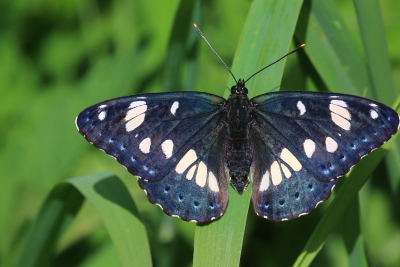


















Southern White Admiral (Limenitis reducta)
2024 photographs highlighted in yellow. Click on any photograph to go to an enlarged picture, or simply scroll down the page.
|
One of the most attractive butterflies, a majestic glider with an unmistakeable flight, gliding for quite long distances interspersed only by a few rapid wingbeats. The upperside has a blue-violet tinge especially when fresh and the underside is a very crisply-patterned pure white on red. It has taken me several years of trying to capture the blue sheen and I still don't really feel that I'm getting close, so these shots really don't do it justice.
The sheen is not unlike that of the Purple Emperor (Apatura iris) in that it is visible at certain angles, but not in the same dramatic way that iris goes from purple to brown. I have seen specimens in earlier years with marked but small red-orange markings on the uph, especially at the anal angle. It is the same size as, and the markings are superficially similar to, the White Admiral (L. camilla) but they are not difficult to tell apart. Camilla does not occur in Var and neighbouring départements, so any Admiral seen there is certain to be reducta. |
I had seen them in most locations across southern France but never in great numbers until 2004 when they were actually very common. They seemed to be attracted to a very small patch of water (almost the only water) in an otherwise completely dry river bed. In one nearby bush I counted nearly 50 nectaring.
The males are very territorial and patrol up and down their stretch, perching on the outer edges of a bush at about 2m off the ground (just high enough to make it difficult to photograph) to warn off potential competitors. They are early emergers in Var and there is a second brood which in long hot dry summers (normal in southern Var) are often noticeably smaller than the spring generation. Some early first brood specimens can be almost black, with very little trace of blue; this seems to be natural and not an effect of ageing. 4882 is a good example. |
| ref | sex |
observations |
alt. m |
| 32172 | M | a male nectaring on some species of Spurge (Euphorbia), perhaps nicaeensis. It's not a great photograph but it does come close to showing the vibrant blue of reducta. I have only seen them nectaring at the end of the day, and Euphorbia is often the preferred source. | 220 |
| 18270 | M |
a male, taking salts. This behaviour is almost as unusual as nectaring. The blue is starting to show here, but somehow the camera just does not capture the vibrancy of the colour. |
1120 |
| 4882 | M |
this early season male appeared almost black, with only a hint of blue in the marginal dashes. I recall that that is how it seemed at the time, so don't think it's a camera-angle effect. Early specimens did seem very dark, so 4882 wasn't that unusual. |
220 |
| 24751 | M | a typical male in territorial pose, ready to see off all intruders. This is the same individual as 24762. | 140 |
| 24762 | M | a male, the same individual as 24751, but in a more relaxed pose. | 140 |
| 36520 | M | a male, posing conveniently on the ground if only for a moment, but this photograph still does not capture the rather iridescent blue that is seen in the field. | 180 |
| 37087 | M | a male, uncharacteristically stopping with open wings. This slightly out of focus shot does at least come close to capturing the deep but dark blue so obvious when seen in the field. | 220 |
| 49559 | PAIR | a pair, female on the left, engaged in some type of courtship ritual. They are not fresh, but have been included here to illustrate the difference between the sexes. | 1550 |
| 50923 | M | a male, yet another attempt to capture the rather iridescent blue reflections of this species. | 220 |
| 50880 | F | a female, rather dull colouring, probably natural and not the effect of ageing. | 220 |
| 40311 | F | a female, and this shot is just starting to capture the bluish colouring. | 220 |
| 42444 | F | another female, nectaring, inevitably, on Euphorbia, with some slight wing damage at the anal angle. | 220 |
| 52084 | F | a female, just starting to catch the blueness of reducta. | 840 |
| 52262 | F | a female that had been part of the mating pair shown in 52231 which had been in copula for some 30 minutes and then parted naturally. | 1550 |
| 40675 | M | a male underside, as evidenced by the territorial pose. | 180 |
| 20151 | M |
possibly a male, if this is a territorial pose, showing the contrast between the deep red and brilliant white bands. |
220 |
| 10197 | M |
a typical territorial pose of a male. |
450 |
| 31512 | M | a male in typical territorial pose. | 20 |
| 52231 | F | the mating pair referenced in 52262, the female above. They were continually on the move, so difficult to get a good photograph of both in the same image, but this is my only photograph of the female underside. | 1550 |
49559_pair_Alpes-Maritimes_2Jul22
52262_female_Alpes-Maritimes_28Jun24
52231_female_Alpes-Maritimes_28Jun24